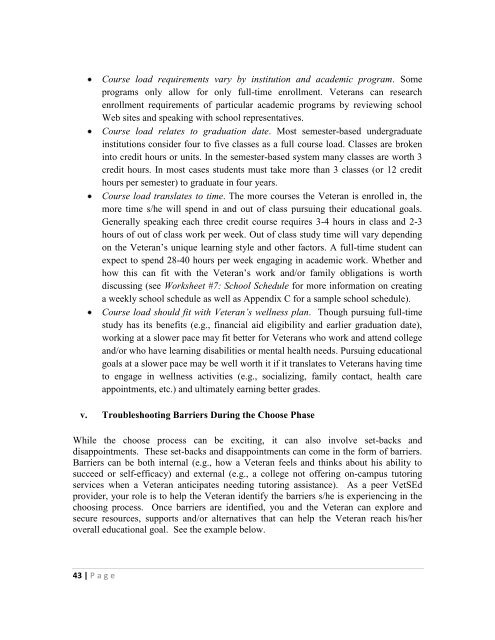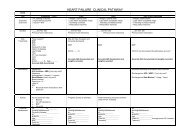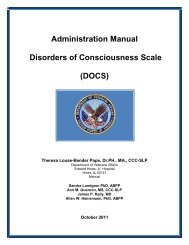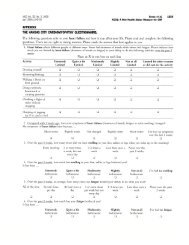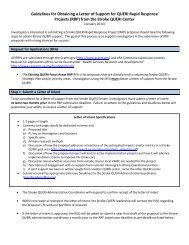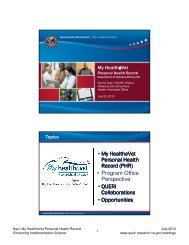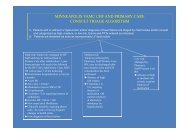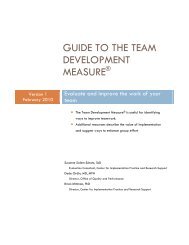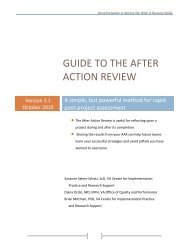The Veteran Supported Education Service Treatment Manual: VetSEd
The Veteran Supported Education Service Treatment Manual: VetSEd
The Veteran Supported Education Service Treatment Manual: VetSEd
Create successful ePaper yourself
Turn your PDF publications into a flip-book with our unique Google optimized e-Paper software.
Course load requirements vary by institution and academic program. Some<br />
programs only allow for only full-time enrollment. <strong>Veteran</strong>s can research<br />
enrollment requirements of particular academic programs by reviewing school<br />
Web sites and speaking with school representatives.<br />
Course load relates to graduation date. Most semester-based undergraduate<br />
institutions consider four to five classes as a full course load. Classes are broken<br />
into credit hours or units. In the semester-based system many classes are worth 3<br />
credit hours. In most cases students must take more than 3 classes (or 12 credit<br />
hours per semester) to graduate in four years.<br />
Course load translates to time. <strong>The</strong> more courses the <strong>Veteran</strong> is enrolled in, the<br />
more time s/he will spend in and out of class pursuing their educational goals.<br />
Generally speaking each three credit course requires 3-4 hours in class and 2-3<br />
hours of out of class work per week. Out of class study time will vary depending<br />
on the <strong>Veteran</strong>‘s unique learning style and other factors. A full-time student can<br />
expect to spend 28-40 hours per week engaging in academic work. Whether and<br />
how this can fit with the <strong>Veteran</strong>‘s work and/or family obligations is worth<br />
discussing (see Worksheet #7: School Schedule for more information on creating<br />
a weekly school schedule as well as Appendix C for a sample school schedule).<br />
Course load should fit with <strong>Veteran</strong>’s wellness plan. Though pursuing full-time<br />
study has its benefits (e.g., financial aid eligibility and earlier graduation date),<br />
working at a slower pace may fit better for <strong>Veteran</strong>s who work and attend college<br />
and/or who have learning disabilities or mental health needs. Pursuing educational<br />
goals at a slower pace may be well worth it if it translates to <strong>Veteran</strong>s having time<br />
to engage in wellness activities (e.g., socializing, family contact, health care<br />
appointments, etc.) and ultimately earning better grades.<br />
v. Troubleshooting Barriers During the Choose Phase<br />
While the choose process can be exciting, it can also involve set-backs and<br />
disappointments. <strong>The</strong>se set-backs and disappointments can come in the form of barriers.<br />
Barriers can be both internal (e.g., how a <strong>Veteran</strong> feels and thinks about his ability to<br />
succeed or self-efficacy) and external (e.g., a college not offering on-campus tutoring<br />
services when a <strong>Veteran</strong> anticipates needing tutoring assistance). As a peer <strong>VetSEd</strong><br />
provider, your role is to help the <strong>Veteran</strong> identify the barriers s/he is experiencing in the<br />
choosing process. Once barriers are identified, you and the <strong>Veteran</strong> can explore and<br />
secure resources, supports and/or alternatives that can help the <strong>Veteran</strong> reach his/her<br />
overall educational goal. See the example below.<br />
43 | P a g e


